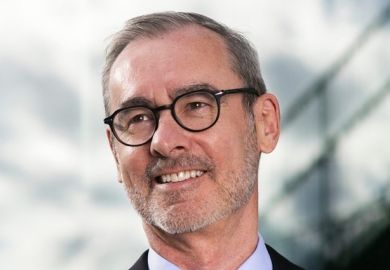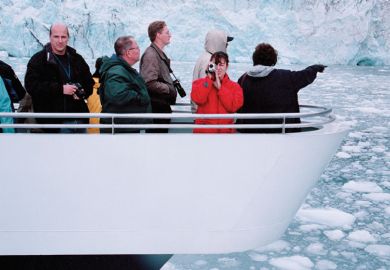The pandemic has been a testing time for all university leaders, but it’s possible none faced as big a challenge as Bill Flanagan.
He accepted his first job as a president, at an institution he was new to, six weeks before the university announced more than 1,000 job losses resulting from the biggest budget cut in the organisation’s history, along with a full-scale move to online teaching thanks to the intensifying pandemic.
Although he describes the situation as a perfect storm and begins his interview with Times Higher Education by joking that he might not survive in the role, the president and vice-chancellor of Canada’s University of Alberta is a man of seemingly inexhaustible equanimity. He describes a scenic spot near the North Saskatchewan River where he sits to look across at the university: “I call it my bench of contemplation.” Lately, he has had a lot to contemplate.
THE Campus views: Fellow vice-chancellors, we must lead the charge on equality
Budget cuts
At the beginning of February 2020, Flanagan accepted the role at Alberta, ending his 28-year career at Queen’s University, which included 14 years as dean of the Faculty of Law. By the end of the month, the government of Alberta had announced what would ultimately become a C$224 million (£133 million) cut in its grant to the university, to be spread out over the following three years; to put it bluntly, Alberta was set to lose more than one-third of its provincial funding.
The province also approved an annual tuition fee increase of 7 per cent for three years, which will make up for some of the loss, but it still leaves Flanagan presiding over a 12 per cent cut to the institution’s C$1.1 billion annual operating budget.
The scale of the problem was so clearly evident that even though Flanagan did not formally assume the role until 1 July, he travelled to Alberta in May and began working 10-hour days towards a plan to turn around the fortunes of the university, which he announced on 2 June.
As someone who had grown up in Alberta, with both parents alumni of the university, he felt strongly that he wanted to be the president who not only steered the university into calmer waters, but on towards a future of prosperity and growth.
Restructuring: a new approach
“Typically, in the past, when universities dealt with cuts, we would just tend to sprinkle these cuts across the institution – everybody takes a 5 per cent cut – without rethinking how we actually provide services,” Flanagan says.
But with cuts of the scale Alberta needed to make, he believed this approach would lead to “one certain outcome: the decline of the university”.
To avoid a deterioration in the quality of research and teaching, Flanagan decided a wholesale restructure was needed; instead of an even sprinkle of cuts, some sections of the university would face a downpour and others would remain largely dry.
Flanagan was aided in this strategy by a data initiative the university had signed up to a few years earlier. UniForum, the brainchild of a vice-president and an academic at the University of New South Wales in Australia, is a coalition of universities that share their management data, enabling them to compare their spending and administrative set-up. Members include the universities of Cambridge, Oxford, Melbourne, Sydney and Toronto.
Flanagan used this tool to help determine where the cuts would need to fall at Alberta. It became apparent, he says, that centralising services was the way to make savings. There were “areas where it was clear that we were spending significantly more than other members in the UniForum group. This included IT and finance and communications.”
The university needed to create larger and fewer academic units so that administrative services could benefit from an economy of scale, Flanagan explains. The data also showed that Alberta had more buildings than other comparable universities and that it could save money on its procurement processes.
So the institution embarked on a programme of administrative and academic restructuring, along with infrastructure and procurement reforms, all at once and in a short space of time, in a bid to save C$127 million a year.
“Any of these would be a very large initiative for a university. But to undertake all of it at once is extraordinary,” Flanagan says.
There was some dissent among university staff; accusations of acting on unreliable data and flawed comparators from dissimilar (British and Australian) systems were levelled. Flanagan’s view is Alberta had much to learn from the other universities.
New colleges
The academic restructuring began with a consultation. The university initially considered combining several faculties into one, but the idea met with huge resistance because it was perceived that faculties were being demoted to schools. Instead, Alberta created a new academic grouping, colleges, in which several faculties would sit.
An issue of vital importance was how to group the faculties. “Did we want to create a College of Arts and Science, grouping faculties engaged in fundamental research? Or did we prefer to create a College of Natural and Applied Science, grouping science with engineering and agriculture, along with a College of Social Sciences and Humanities, grouping arts with law, education and business?” asks Flanagan.
This was ultimately a question for Alberta’s main academic governance body, the General Faculties Council (GFC). After a long debate, they settled on the creation of three colleges: a College of Social Sciences and Humanities (grouping arts, law, business and education), a College of Natural and Applied Science (grouping science, engineering, agriculture, life and environmental sciences) and a College of Health Sciences (grouping medicine and dentistry, nursing, pharmacy, public health, rehabilitation medicine and kinesiology).
‘That’s a lot of deans’
When he agreed to take the president’s role, the first thing Flanagan was asked to do, he says, was to phone all the deans. Learning that there were 18 of them, he was shocked. “I was like, wow, that’s a lot of deans. That would be a very difficult leadership structure.”
But his proposal for a new management structure, following the agreement of the new colleges, caused a dispute. The GFC – comprised of university vice-presidents, faculty deans, professors, students, librarians, and academic and non-academic staff – suggested a “council of the deans” for each college, with no single individual ultimately in charge, arguing that a new layer of management would increase costs. The board of governors disagreed; they wanted one person to be accountable for the new colleges.
Some called the stand-off a “crisis in governance”, but for Flanagan it was “an interesting conversation”.
“In any university with a bicameral system, there are always these interesting conversations that take place between the academic governing body and the board of governors. And this is one of those,” he says.
In the end, the board won out; the colleges will be led by college deans. Now Flanagan feels the pressure to demonstrate to faculty that this new administrative layer will help the university save money.
Lesson learned: get to know the board and inspire
Would he do anything differently if he had to do this whole year again?
“I think perhaps looking back on it, I was so engaged with just trying to build the plan and trying to bring the university community together that it was also very hard to build all those relationships with the board members, to bring all of that along at the same time,” Flanagan admits. “I might have spent a bit more time in that regard.”
To affect change, Flanagan believes a leader needs to impress the urgency on everyone involved as well as provide them with a positive vision for the future. The urgency was apparent thanks to the unprecedented budget cut, but the optimistic vision was a little harder.
Flanagan wants to convey the notion that the new college structure will provide opportunities beyond saving cash.
“Twenty-five years from now, when I’ve long departed the scene, I don’t think anyone’s going to be saying the colleges were a great idea because they saved us money. I hope people are saying the colleges were a great idea because they enabled us to advance interdisciplinary teaching and research, in a way we’ve never been able to do before,” he says.
Alberta’s changing demographics provide another beacon of hope: the number of high school graduates in Alberta will grow by up to 25 per cent over the next six years, he says, and Flanagan aims to swell the ranks of students from 40,000 to 50,000. Online learning, too, he hopes, will provide the university with opportunities to reach more students.
If this plan for growth succeeds, Flanagan will appoint 500 new academic roles, ultimately leading to a larger academic workforce and fewer administration staff to support them. But he’s clear that he does “not want academics picking up increased administrative load”.
Inspiring people is difficult when redundancy is in the air, so what is the best way to handle 1,200 job cuts?
“There’s no easy way to do that. I wouldn’t claim to have developed an easy way to do that,” he says.
“But I think showing respect, empathy as much as you can, communicating as transparently as you can about the changes and why they’re necessary and how this will advance the university.
“And then again, most importantly, a vision going forward to lift people’s eyes up to where the university can be and where this will take us.”
Lesson learned: patience
Although Flanagan is new to being a v-c, earlier in his career he chaired the boards of several HIV/Aids non-profit organisations, which taught him much about leadership. They were complex organisations, “with so much urgency, because people were dying”.
“These were really, really important organisations, but also organisations under a great deal of strain and stress and occasionally conflict and high emotions, given just the tragedy of what we were dealing with as a community,” he says.
At first, Flanagan says, his approach was that everything needed to be done yesterday. “But I realised that if you push too hard and you’re not pulling people along with you, you’re not going to succeed.”
He is still someone who feels the urgency, but now he works to build his case and garner support for it. It was this topic he pondered last month, sitting on his bench of contemplation.
“I was thinking about how to continue to bring the university community along,” he says. “The next year is going to be very challenging because we still have ongoing job reductions and budget cuts, the restructuring is very challenging…so how do we continue to work together to move the university forward? Those were my thoughts on the bench.”
Quick facts
Born: 1960 in Stony Plain, a town in Alberta
Academic qualifications: BA in English and philosophy from Carleton University; JD from the University of Toronto; DEA in international economic law from Panthéon-Sorbonne University – Paris 1; LLM from Columbia University
Lives with: His husband
Academic heroes: Roberto Unger, a professor of jurisprudence, and Jagdish Bhagwati, a professor of economics and law
This is part of our “Talking leadership” series of 50 interviews over 50 weeks with the people running the world’s top universities about how they solve common strategic issues and implement change. Follow the series here.
Register to continue
Why register?
- Registration is free and only takes a moment
- Once registered, you can read 3 articles a month
- Sign up for our newsletter
Subscribe
Or subscribe for unlimited access to:
- Unlimited access to news, views, insights & reviews
- Digital editions
- Digital access to THE’s university and college rankings analysis
Already registered or a current subscriber?










